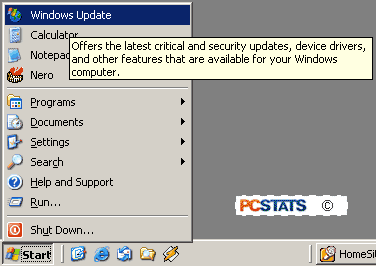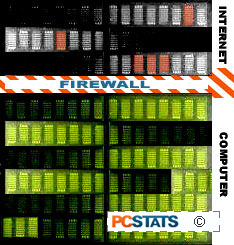|
|
Post by StRiDeR on Jan 4, 2004 9:39:55 GMT 8
sweet girlz....nanti kau nak ambil degree, nak sambung kat U maner?  |
|
|
|
Post by atokENSEM on Jan 4, 2004 18:38:54 GMT 8
sweet girlz....nanti kau nak ambil degree, nak sambung kat U maner?  die ckp kt atok..dia nk samb kat United kingdom..tul kan s.girlz?    |
|
|
|
Post by StRiDeR on Jan 5, 2004 19:07:05 GMT 8
con't... page 2 - Beginners Guides: Firewalls and Internet Security ------------------------------------------------------------------- Some General Tips Use passwords. Both Windows 2000 and XP have the ability to set effective user passwords to prevent others from using the account. They also have a default user called 'administrator' with full rights to the system and other user accounts, and no password unless you gave it one during the installation process. Worse still, Windows 2000 and XP Professional systems create a secret share (a share is a condition set on a drive or folder which allows it to be accessed from another computer), accessible only to members of the administrators group, for every drive in your computer. To sum up, if you do not have a password on your administrator account, almost every single part of your computer can be accessed and controlled remotely. The danger is slightly lessened in Windows XP, since network shares are not enabled by default, but if they are enabled, you are at risk. To assign passwords on Windows 2000, go to 'my computer'/control panel/users and passwords. To assign passwords on XP, go to start/control panel/user accounts, pick the user you wish to edit, then select 'change my password.' Note that to perform this operation, you need administrative privileges, meaning you must be logged in either as administrator, or as a user account you created in XP during the install process, since these accounts are also members of the administrators group by default. It is also a very good idea to change the name of the 'administrator' account to something less obvious, like maybe 'Bob.'  Update your software. Update your software. This cannot be stressed enough, especially with anti-virus software. Most anti-virus packages will prompt you if it has been a while since they were able to update their virus definitions (the 'signatures' of computer viruses the antivirus software will search for), so make sure you do. The software cannot stop what it does not know about. Updating your Windows operating system is just as important. Microsoft puts out security fixes at a rapid rate, and while this nets them abuse for the amount of holes in their operating systems, it also shows that they are committed to putting out the fires, if not preventing them. Versions of Windows from 98 up contain a direct link to the windows update site on the start menu, and Windows 2000 (with service pack 3) and XP have an automatic update feature which will download the latest updates automatically. Stay up-to-date.  Be careful with file-sharing services like Kazaa. Be careful with file-sharing services like Kazaa. Unlike a couple of years ago, they are now crawling with viruses, adware and other general unpleasantness. If you are going to use them to download files, make sure to check more than just the name in the first column of the search. Make sure the general size of the file seems right, and especially check the actual file name of the file you are downloading. This is not foolproof, but nothing is when dealing with peer-to-peer sharing software. |
|
|
|
Post by SweetGirlz on Jan 6, 2004 2:30:53 GMT 8
die ckp kt atok..dia nk samb kat United kingdom..tul kan s.girlz?    bkn tok!australia la..  |
|
|
|
Post by StRiDeR on Jan 6, 2004 8:29:17 GMT 8
bkn tok!australia la..  oooo, Universiti aper?....major aper, sweet girlz?  |
|
jaga_um
Senior Student
  eidolon..eidolon..eidolon... warg..warg..warg... i summon the fire ice...
eidolon..eidolon..eidolon... warg..warg..warg... i summon the fire ice...
Posts: 320
|
Post by jaga_um on Jan 6, 2004 8:55:02 GMT 8
jom sambung kat lam negara.... ;D
|
|
|
|
Post by enigma on Jan 6, 2004 9:31:02 GMT 8
jom sambung kat lam negara.... ;D awak ni memang patriotik sunnguh la kozzy....untung negara ni dot org cam awak...  |
|
jaga_um
Senior Student
  eidolon..eidolon..eidolon... warg..warg..warg... i summon the fire ice...
eidolon..eidolon..eidolon... warg..warg..warg... i summon the fire ice...
Posts: 320
|
Post by jaga_um on Jan 6, 2004 11:52:52 GMT 8
awak ni memang patriotik sunnguh la kozzy....untung negara ni dot org cam awak...  tima kacih..tima kacih..ini pujian yang pertama aku dapat darimu enigma...hehehehehe ;D |
|
|
|
Post by enigma on Jan 6, 2004 12:41:12 GMT 8
tima kacih..tima kacih..ini pujian yang pertama aku dapat darimu enigma...hehehehehe ;D same2..bkn senang org nk mendapat pujian dariku kozzymind.....hehehhehee  |
|
jaga_um
Senior Student
  eidolon..eidolon..eidolon... warg..warg..warg... i summon the fire ice...
eidolon..eidolon..eidolon... warg..warg..warg... i summon the fire ice...
Posts: 320
|
Post by jaga_um on Jan 6, 2004 14:06:13 GMT 8
same2..bkn senang org nk mendapat pujian dariku kozzymind.....hehehhehee  ya allah nasib sedar..ku ingatkan..tak ingat dunia...eureka..eureka..eureka..eureka |
|
|
|
Post by turtle on Jan 6, 2004 17:45:16 GMT 8
eh ape nie?? histeria ker ape
|
|
|
|
Post by StRiDeR on Jan 6, 2004 19:40:20 GMT 8
page 3-Dealing with Anti-virus software ----------------------------------------------------- For any Internet connected PC or network, a regularly updated anti-virus program is a must. Standard Anti-virus software works by examining individual files within your hard disk for telltale signs, or signatures, of specific virus programs. A program using this method, called 'exact detection', is only as good as its database of known virus definitions, which is why it is important to update frequently. The major anti-virus software companies used this approach exclusively, until recently when they have begun flirting with the other major method of virus detection, heuristic detection. This method does not define a virus by matching the exact pattern of data that makes up its signature, but rather by observing its behavior. or example, a heuristic (Greek for 'to find') anti-virus program might be instructed to watch for non-authorized programs that attempt to make changes to the computer's registry, or to access system files. There are many different methods of implementing heuristic anti-virus software, but that is really beyond the scope of this article. The major reason behind the partial adoption of heuristic anti-virus methods by the big companies such as Symantec (makers of Norton Antivirus) is the success in recent years of mass-mailing worms. Worm are computer viruses which replicate themselves through email. The incredibly fast rate of infection seen in cases such as the vbs.loveletter worm (which you may recognize as the 'I love you virus'), Anna, and recently the w32.bugbear worm took the major anti-virus manufacturers off-guard. They were not able to release virus definitions fast enough to prevent major distribution of the aforementioned viruses. The major virus protection companies are now incorporating features into their software which will allow it to detect behavior characteristic of these mass-mailing worms, without necessarily having a virus signature for them, hoping to head off such outbreaks in the future... at least among paying customers. For home use, an antivirus software package is highly recommended. Symantec's Norton Antivirus and MacAfee's VirusScan are two leaders in the area, but the brand name does not matter as much as the frequency of the virus updates which the company offers. There are several other reputable packages available besides these, especially for the business world. For software such as this, which needs to be frequently updated by the manufacturer, expect to pay a subscription fee in the future. Most home anti-virus software ships with a one-year subscription to the company's updating service, after which you will need to renew. If you suspect you already have a virus on your computer, and you either do not have access to an anti-virus program or the one you do have does not seem to be doing the job (not too surprising, as many viruses include disabling the functionality of major anti-virus checkers as part of their payload), all is not lost. There are resources available on the Internet for identifying and eliminating viruses manually. As a start, you can go to www.sarc.com This is Symantec's public virus threat information website. If you use the encyclopedia, you can find information and removal tools or instructions for many recent viruses. On the same page there is a link to the Symantec security check, which will scan your computer and identify any viruses that fit a known signature, using their latest definitions. It will not remove them of course, but it's a start. Then you can look them up in the virus encyclopedia for removal instructions. |
|
|
|
Post by atokENSEM on Jan 7, 2004 2:12:13 GMT 8
bkn tok!australia la..  Ooo.. tp jd ke?s.girlz dpt biasiswa tak? |
|
|
|
Post by atokENSEM on Jan 7, 2004 2:13:48 GMT 8
eh ape nie?? histeria ker ape ni lah pot puji memuji..  |
|
|
|
Post by StRiDeR on Jan 7, 2004 19:42:37 GMT 8
page 4 - Firewalls and Internet security ----------------------------------------------------- No doubt you've heard about firewalls. Everyone on the Internet has heard the term at one time or another. They are for protecting your computer from the big bad Internet, right? Well, yes, essentially. They can also control access out to the Internet from your computer, but what are they really, and how do they work? A firewall is a piece of hardware, or a software program that examines data passing into your computer or network and discards it if it does not meet certain criteria. Depending on the type of firewall you use, this operation may take place at different points in the path between the source of the data and the application in your computer it is intended for, and different criteria will be used to examine the data, but the basic operation remains the same for all firewalls. There are four distinct types of firewall method, which may be used individually or combined into a firewall product:  Packet filtering Packet filtering Packet filtering firewalls work by examining data packets as they attempt to pass through the firewall, and comparing them to a list of rules based on the source of the data, the destination it is intended for, and the port the data was sent from and intends to connect to. A firewall using packet filtering can be easily configured to stop certain forms of information flowing in or out of a computer or network by blocking well-known ports. For example, setting a packet-filtering firewall to block data traveling out of the firewall from any source, using port 80 (the standard port used for http, or web-browsing data) will have the effect of disabling web browsing on all computers inside the firewall. Likewise, if you were hosting a website on your computer and you set your firewall to drop all data coming into the network on port 80 from any source, no-one outside your network would be able to view your website. The limitation of packet filters is that ports and IP addresses are all they will filter. They don't care about the content of the data, just where it's headed. They also require some technical knowledge if you wish to customize them. Most cable/DSL routing devices can use packet filtering as a part of their firewall protection. Circuit level gateways A circuit level gateway is a firewall that only allows data into its protected network based on requests that come from computers inside that network. The firewall keeps a record of requests for data that go out, and only allows data in that matches with a request. An advantage of this type of firewall is that since it acts as the gateway to the network it is protecting, anyone scanning the network from outside will see only the address of the firewall, not the rest of its protected network. |
|